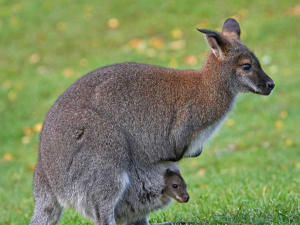Biosecurity NZ ramps up hunt for yellow-legged hornet on Auckland’s North Shore
Biosecurity New Zealand is intensifying its campaign to locate and eliminate the invasive yellow-legged hornet, following confirmed detections on Auckland's North Shore.
 Biosecurity NZ has launched a new campaign targeting wallabies. Photo Credit: Ministry for Primary Industries.
Biosecurity NZ has launched a new campaign targeting wallabies. Photo Credit: Ministry for Primary Industries.
Wallaby populations continue to grow in New Zealand, something which has prompted the launch of the first national awareness campaign.
The Tipu Mātoro: Wallaby-free Aotearoa is designed to shine a light on the extensive damage wallabies can wreak on the environment, asking Kiwis to report wallaby sightings.
John Walsh, Biosecurity New Zealand’s director of response says wallabies silently prey on the futures of forests and farms.
“We are working in partnership with regional councils, local iwi, farmers and landowners through Tipu Mātoro to manage and reduce populations, but we need everyone’s help.”
Walsh says estimates set the wallaby population at more than one million. However, because the animals are nocturnal and good at hiding, public reports are one of the best ways to manage the spread.
With no natural predators, two introduced species are causing millions in damage each year – the dama wallaby in Rotorua, and the Bennett’s wallaby in Canterbury and North Otago.
“If left unchecked, by 2025 wallabies would cost New Zealanders around $84 million a year in damage and over the next 50 years, they could spread through a third of the country,” Walsh says.
“Wallabies graze on bush undergrowth, and, when moving into an area, can quickly decimate new shoot growth, destroying our native species' habitats and food sources. What were once lush forest understories turn into barren wastelands, meaning that in the coming years our native bush won’t regenerate.
“And their impacts are felt beyond our native bush. They compete with livestock for food, damage fences, foul up pastures preventing it from being a food source, eat planted forest seedlings and contribute to erosion and poor water quality.”
Walsh says the campaign is part of the Tipu Mātoro: Wallaby-free Aotearoa Programme, which focuses first on stopping the spread of wallabies from known areas in the Bay of Plenty/Waikato and in South Canterbury/North Otago.
“By targeting populations outside these containment zones and following up on reported wallaby sightings, the programme can prevent new populations establishing elsewhere in Aotearoa.”
The programme is also undertaking the significant research required to understand wallaby behaviour in a New Zealand context, supporting effective containment and control.
To report a wallaby sighting, head to http://www.reportwallabies.nz/
The National Wild Goat Hunting Competition has removed 33,418 wild goats over the past three years.
New Zealand needs a new healthcare model to address rising rates of obesity in rural communities, with the current system leaving many patients unable to access effective treatment or long-term support, warn GPs.
Southland farmers are being urged to put safety first, following a spike in tip offs about risky handling of wind-damaged trees
Third-generation Ashburton dairy farmers TJ and Mark Stewart are no strangers to adapting and evolving.
When American retail giant Cosco came to audit Open Country Dairy’s new butter plant at the Waharoa site and give the green light to supply their American stores, they allowed themselves a week for the exercise.
Fonterra chair Peter McBride says the divestment of Mainland Group is their last significant asset sale and signals the end of structural changes.